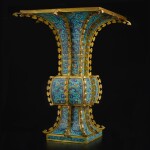
Property from the Brooklyn Museum, sold to support museum collections
A exceptionally large cloisonné enamel beaker vase, fangzun, Qing dynasty, 17th / 18th century | 清十七 / 十八世紀 銅胎掐絲琺瑯仿古饕餮紋出戟大方尊
Auction Closed
March 17, 03:03 PM GMT
Estimate
100,000 - 150,000 USD
Lot Details
Description
A exceptionally large cloisonné enamel beaker vase, fangzun
Qing dynasty, 17th / 18th century
清十七 / 十八世紀 銅胎掐絲琺瑯仿古饕餮紋出戟大方尊
of square section modeled after archaic zun vessels, each side of the central bulb enameled with a stylized taotie mask amidst scrolling lotus blooms, the tall trumpet neck decorated with archaistic lappets enclosing interlocking scrolls and further lotus, the splayed foot similarly enameled, with notched vertical flanges dividing each side and at each corner, the interior of the mouth decorated with further lotus scroll, all reserved on a turquoise ground, the rims gilt
Height 24 in., 60.2 cm
Collection of Robert Hoe III (1839-1909).
American Art Association, New York, 18th February 1911, lot 888.
Collection of Samuel P. Avery, Jr. (1847-1920).
Gifted to the Brooklyn Museum, Brooklyn, in 1911 (acc. no. 09.933.3).
來源
Robert Hoe III (1839-1909) 收藏
美國藝術聯盟,紐約,1911年2月18日,編號888
Samuel P. Avery, Jr. (1847-1920) 收藏
1911年贈予布魯克林博物館,布魯克林 (館藏編號09.933.3)
Blue of Jingtai. The Samuel P. Avery, Jr. Collection of Chinese Cloisonné Enamels, Brooklyn Museum, Brooklyn, 1990-93.
展覽
《Blue of Jingtai. The Samuel P. Avery, Jr. Collection of Chinese Cloisonné Enamels》,布魯克林博物館,布魯克林,1990至1993年
John Getz, Catalogue of the Avery Collection of Ancient Chinese Cloisonnés, New York, 1912, pl. 38.
出版
John Getz,《Catalogue of the Avery Collection of Ancient Chinese Cloisonnés》,紐約,1912年,圖版38
The present vase, with its majestic construction and elaborate enameling, celebrates the 18th century interest in antiquity. The squared beaker form adorned with crisply cast flanges is based on a ritual bronze vessel of the Zhou dynasty, specifically a zun of square section. The design juxtaposes motifs taken from or inspired by the Zhou dynasty prototypes, such as the taotie masks to the central register and blades to the foot, with those found in contemporary porcelains, lacquers and textiles. Parts of the vessel which did not exist, or which would have been left blank in the Zhou dynasty original, have been filled with lotus blooms, demonstrating the craftsmen's freedom to improvise.
Only a small number of zun-form vessels of this extremely large size are known. Compare one of the same size and similar design in the Palace Museum, Beijing, illustrated in Gugong bowuyuan cangpin daxi: falangqi bian [Compendium of Collections in the Palace Museum: Cloisonné] vol. 2, Beijing, 2011, pl. 36.
Slightly smaller cloisonné enamel zun measuring approximately 55 cm high include a Qianlong mark and period example in the National Palace Museum, illustrated in Enamel Ware in the Ming and Ch'ing Dynasties, Taipei, 1999, pl. 49; one illustrated in Helmut Brinker and Albert Lutz, Chinese Cloisonné: The Uldry Collection, New York, 1989, pl. 212; and another with an apocryphal cast Jingtai mark was sold at Christie's New York, 25th March 1998, lot 89.
